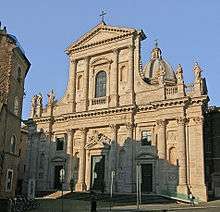San Giovanni dei Fiorentini
| San Giovanni dei Fiorentini | |
|---|---|
 | |
| Basic information | |
| Location |
|
| Geographic coordinates | Coordinates: 41°53′59″N 12°27′54″E / 41.899697°N 12.465022°E |
| Affiliation | Roman Catholic |
| District | Rione Ponte, Rome |
| Architectural description | |
| Architect(s) | Giacomo della Porta |
| Architectural type | Church |
| Architectural style | Baroque |
| Groundbreaking | 1523 |
| Completed | 1734 |
San Giovanni dei Fiorentini is a minor basilica and a titular church in the Ponte rione of Rome.
Dedicated to St. John the Baptist, the protector of Florence, the new church for the Florentine community in Rome was started in the 16th century and completed in early 18th and is the national church of Florence in Rome.
The main façade fronts onto the Via Giulia. This straight street was an urban initiative, carried out in 1508 by the architect Donato Bramante at the instigation of Pope Julius II Della Rovere, which cut through the irregular urban fabric to the Ponte Sant'Angelo, the bridge which crosses over the Tiber River to the Castel Sant'Angelo and St. Peter's Basilica.
History


Julius II's successor, the Florentine Pope Leo X de Medici (1513-1521) initiated the architectural competition for a new church in 1518 on the site of the old church of San Pantaleo. Designs were put forward by a number of architects, among them Baldassare Peruzzi, Jacopo Sansovino, Antonio da Sangallo the Younger and the painter and architect Raphael. The dominant initial ideas were for a centralised church arrangement.[1]
Sansovino won the competition but the building construction was subsequently executed by Sangallo and Giacomo della Porta.[2]
In 1559, Michelangelo was asked by Cosimo I de Medici, Duke of Tuscany, to prepare designs for the church and he presented a centralised church arrangement but this was not adopted.[3]

The main construction of the church was carried out between 1583-1602 under the architect Giacomo della Porta based on the Latin cross arrangement. Carlo Maderno took over from 1602-1620 and directed construction of the dome and the main body of the church completed. However, the main façade, based on a design by Alessandro Galilei was not finished until 1734.[4]
In 1623-24 Giovanni Lanfranco produced paintings for the Sacchetti chapel.[5]
In 1634, the Roman Baroque painter and architect, Pietro da Cortona, was asked by the Florentine nobleman Orazio Falconieri to design the high altar.[6] Drawings for the altar and its setting and a model were prepared but the project was not carried out. Cortona's ideas for the choir included windows hidden from the view of the congregation that would illuminate the altarpiece, an early example of the Baroque usage of a "hidden light" source, a concept which would be much employed by Bernini. Some twenty to thirty years later, Falconieri resurrected the choir project but gave the commission to the Baroque architect, Francesco Borromini who changed the design to allow for the burial of Orazio's brother Cardinal Lelio Falconieri. After Borromini died in 1667, the work was completed and partly modified by Cortona and on his death in 1669, by Ciro Ferri, Cortona’s pupil and associate.[7]
A Cardinal's Church
By a decree of Pope John XXIII of 12 March 1960, San Giovanni dei Fiorentini became a titular church for Cardinal Priests. Its first incumbent was Cardinal Joseph-Charles Lefèbvre, Archbishop of Bourges, who was appointed on 28 March 1960. He died on 2 April 1973. His successor, appointed on 24 May 1976, was Cardinal Juan Carlos Aramburu, Archbishop of Buenos Aires, who held the title Cardinal Protector until his death on 18 Nov 2004. He was succeeded by Cardinal Carlo Caffarra, (now retired) Archbishop of Bologna, on 24 March 2006.[8]
Burials
Francesco Borromini is buried under the dome.[9]
References

- ↑ Heydenreich, L.; Lotz, W. (1974). "Architecture in Italy 1400-1600". Pelican History of Art. p. 195-196.
- ↑ "Chiesa di San Giovanni Battista dei Fiorentini". Lonely Planet. Retrieved 7 August 2015.
- ↑ Heydenreich & Lotz, 1974, p. 257
- ↑ Guide Rionali di Roma , Rione V, Ponte, Parte IV, 1975, p.16 (in Italian)
- ↑ "Giovanni Lanfranco". Matthiesen Gallery. Archived from the original on May 15, 2006. Retrieved 8 March 2015.
- ↑ Blunt, Anthony. Guide to Baroque Rome, Granada, 1982, p.51; Merz, Jorg Martin. Pietro da Cortona and Roman Baroque Architecture, Yale, 2008, pp 87-91
- ↑ Merz, J.M. 2008,p 90-91
- ↑ David M. Cheney, Catholic-Hierarchy. Retrieved 03/09/2016.
- ↑ "San Giovanni dei Fiorentini". Rome Sights. Fodor's. Retrieved 20 January 2013.
Bibliography
- Emilio Rufini, S. Giovanni de' Fiorentini (Roma: Marietti, 1957).
- Paolo Portoghesi, Roma Barocca (Roma: Laterza, 1966).
- Luigi Lotti, S. Giovanni dei Fiorentini (Roma: Alma Roma, 1971).
External links
| Wikimedia Commons has media related to Church of San Giovanni Battista dei Fiorentini. |